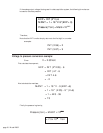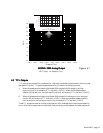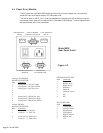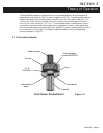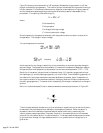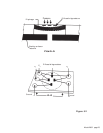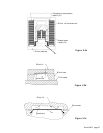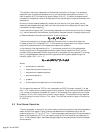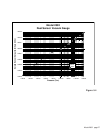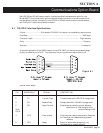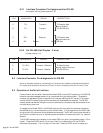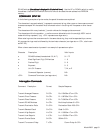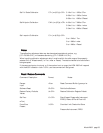page 26 Model 2002
This radiation loss is also independent of the thermal conductivity of the gas. It is somewhat
dependent upon the absolute temperature of R
s
and the ambient temperature, but since ∆T is
kept to less than 20°C, this loss is only approximately 10% of E
s
. If ambient changes are small
compared to the absolute values of the temperature this loss can approximated as a constant with
temperature.
Since the first two losses are essentially constant at high vacuum for a given sensor, we can
measure these losses and subtract them from the input power which leaves only the rate of heat
transmission through the gas (E
g
).
In the viscous flow regime, the E
g
loss is directly dependent on the thermal conductivity of the gas
(K
g
), the surface area of the membrane, the differential temperature and is inversely proportional
to distance between the membrane and the lid. It can be written as
EE
EE
E
gg
gg
g
= (K = (K
= (K = (K
= (K
gg
gg
g
∆∆
∆∆
∆
T T
T T
T
AA
AA
A
ss
ss
s
)/)/
)/)/
)/
∆∆
∆∆
∆
xx
xx
x
The thermal conductivity of the gas is essentially constant when in viscous flow where the
Knudsen number (Kn) is less than 0.01. In the viscous flow regime there is no change in sensor
output with pressure since all of the losses are constants with pressure.
In the molecular flow regime where (Kn > 1) the thermal conductivity of the gas becomes
directly proportional to the gas pressure as shown below. We can expect then that E
g
will be
constant at high pressures and directly proportional to the pressure at low pressures. The energy
loss E
g
, changes between these two controlling equations as the system passes through the
transition region (0.01 < Kn < 1).
EE
EE
E
gg
gg
g
= =
= =
=
aa
aa
a
rr
rr
r
LL
LL
L
tt
tt
t
(273/T(273/T
(273/T(273/T
(273/T
hh
hh
h
))
))
)
1/21/2
1/21/2
1/2
(T(T
(T(T
(T
hh
hh
h
-T-T
-T-T
-T
aa
aa
a
)A)A
)A)A
)A
gg
gg
g
PP
PP
P
Where
a
r
= accomodation coefficient
L
t
= free molecule thermal conductivity
T
h
= temperature of heated membrane
T
a
= ambient temperature
P = pressure
A
g
= surface area of the heated portion of the membrane
For nitrogen at a pressure of 760 Torr and a temperature of 20°C the mean free path (λ) is less
than 1 x 10
-7
meters and is inversely proportional to pressure. Since the thermal transfer distance
(∆x) is a few micrometers, this sensor will remain in the molecular flow regime at a much higher
pressure (10 Torr) than is typical for a thermal vacuum gauge. This extends the linear response
part of the output curve up into the 1 Torr range. The nonlinear transition region will extend up
to 1000 Torr.
5.3 Dual Sensor Operation
The microprocessor in the control unit continuously monitors the outputs of both the piezoresistive
sensor and the Pirani sensor. Figure 5.4 shows representations of the sensors output over the
pressure range from 10
-5
Torr to 10
+3
Torr. The microprocessor uses the output of the piezoresistive
sensor at high pressures (>32 Torr) and uses the output of the Pirani sensor at low pressures (<8
Torr). In the crossover region, a software averaging algorithm ensures a smooth transition between
the two sensors.



